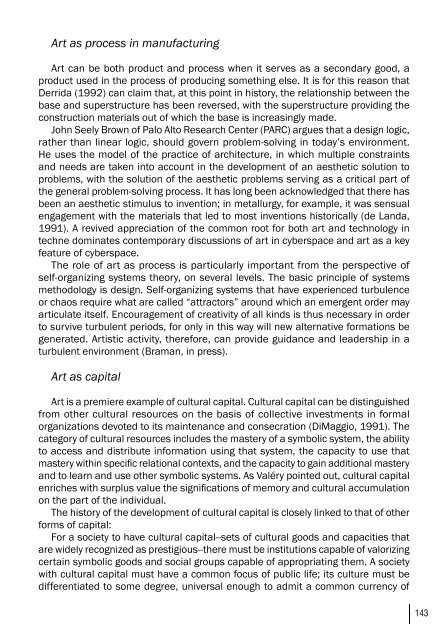art-e-conomy _ reader - marko stamenkovic
art-e-conomy _ reader - marko stamenkovic
art-e-conomy _ reader - marko stamenkovic
Create successful ePaper yourself
Turn your PDF publications into a flip-book with our unique Google optimized e-Paper software.
Art as process in manufacturing<br />
Art can be both product and process when it serves as a secondary good, a<br />
product used in the process of producing something else. It is for this reason that<br />
Derrida (1992) can claim that, at this point in history, the relationship between the<br />
base and superstructure has been reversed, with the superstructure providing the<br />
construction materials out of which the base is increasingly made.<br />
John Seely Brown of Palo Alto Research Center (PARC) argues that a design logic,<br />
rather than linear logic, should govern problem-solving in today’s environment.<br />
He uses the model of the practice of architecture, in which multiple constraints<br />
and needs are taken into account in the development of an aesthetic solution to<br />
problems, with the solution of the aesthetic problems serving as a critical p<strong>art</strong> of<br />
the general problem-solving process. It has long been acknowledged that there has<br />
been an aesthetic stimulus to invention; in metallurgy, for example, it was sensual<br />
engagement with the materials that led to most inventions historically (de Landa,<br />
1991). A revived appreciation of the common root for both <strong>art</strong> and technology in<br />
techne dominates contemporary discussions of <strong>art</strong> in cyberspace and <strong>art</strong> as a key<br />
feature of cyberspace.<br />
The role of <strong>art</strong> as process is p<strong>art</strong>icularly important from the perspective of<br />
self-organizing systems theory, on several levels. The basic principle of systems<br />
methodology is design. Self-organizing systems that have experienced turbulence<br />
or chaos require what are called “attractors” around which an emergent order may<br />
<strong>art</strong>iculate itself. Encouragement of creativity of all kinds is thus necessary in order<br />
to survive turbulent periods, for only in this way will new alternative formations be<br />
generated. Artistic activity, therefore, can provide guidance and leadership in a<br />
turbulent environment (Braman, in press).<br />
Art as capital<br />
Art is a premiere example of cultural capital. Cultural capital can be distinguished<br />
from other cultural resources on the basis of collective investments in formal<br />
organizations devoted to its maintenance and consecration (DiMaggio, 1991). The<br />
category of cultural resources includes the mastery of a symbolic system, the ability<br />
to access and distribute information using that system, the capacity to use that<br />
mastery within specific relational contexts, and the capacity to gain additional mastery<br />
and to learn and use other symbolic systems. As Valéry pointed out, cultural capital<br />
enriches with surplus value the significations of memory and cultural accumulation<br />
on the p<strong>art</strong> of the individual.<br />
The history of the development of cultural capital is closely linked to that of other<br />
forms of capital:<br />
For a society to have cultural capital--sets of cultural goods and capacities that<br />
are widely recognized as prestigious--there must be institutions capable of valorizing<br />
certain symbolic goods and social groups capable of appropriating them. A society<br />
with cultural capital must have a common focus of public life; its culture must be<br />
differentiated to some degree, universal enough to admit a common currency of<br />
143


